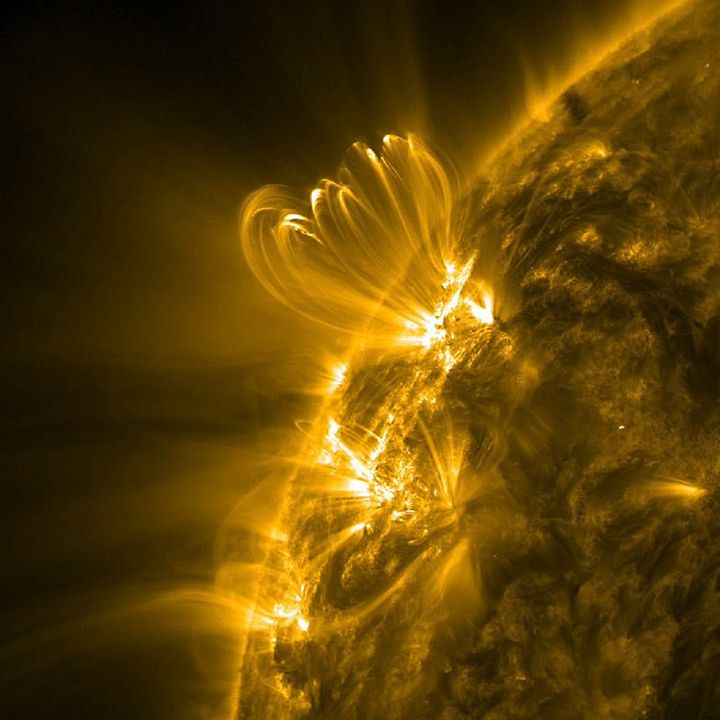Understanding Solar Flares: A Breakthrough in Predictive Science
For many years, the scientific community has been striving to develop accurate methods for predicting solar flares. These are intense flashes of light emanating from the Sun, which can release a massive number of charged particles into the solar system. Such events can have significant impacts on space weather, affecting satellite operations, communication systems, and even power grids on Earth. Thanks to the efforts of a dedicated team using NASA’s Solar Dynamics Observatory (SDO), a promising breakthrough has been achieved. They have discovered flickering loops in the Sun’s corona, which appear to act as indicators of upcoming large solar flares.
The Significance of Solar Flares
Solar flares are powerful bursts of radiation that occur when magnetic energy built up in the Sun’s atmosphere is suddenly released. When these flares reach Earth, they can interact with our planet’s magnetic field, potentially causing disruptions in technology and posing risks to astronauts in space. Understanding and predicting these events are crucial for minimizing their adverse effects on our technological society.
NASA’s Solar Dynamics Observatory: A Closer Look
Launched in 2010, NASA’s Solar Dynamics Observatory is a pivotal tool in the study of the Sun. It provides continuous observations of the solar surface and atmosphere, capturing images in multiple wavelengths of light. This comprehensive data allows scientists to analyze solar activity and its effects on space weather.
Flickering Loops: A Predictive Indicator
The recent discovery by the team using the SDO involves observing flickering loops in the Sun’s corona. The corona is the outer layer of the Sun’s atmosphere, characterized by its extremely high temperatures and magnetic activity. These flickering loops are believed to be regions where energy is being stored and then released, leading to solar flares. By monitoring these loops, scientists can potentially forecast when a significant flare is likely to occur.
How the Discovery Was Made
The team employed advanced imaging techniques and data analysis tools to identify the flickering patterns in the corona. They focused on specific areas of the solar surface where magnetic fields are particularly intense. By studying these regions over time, they were able to correlate the flickering loops with subsequent solar flare events.
Implications for Space Weather Prediction
The ability to predict solar flares with greater accuracy would be a significant advancement in space weather forecasting. It would enable better preparation and mitigation strategies to protect satellites, communication networks, and other critical infrastructure from the effects of solar activity. Moreover, it would enhance the safety of astronauts during space missions by providing timely warnings of increased radiation exposure.
A Step Forward in Solar Research
This breakthrough represents a major step forward in our understanding of solar dynamics and the mechanisms behind solar flares. It opens up new avenues for research, with the potential to refine and improve predictive models further. As scientists continue to explore the intricacies of the Sun’s behavior, our ability to anticipate and respond to solar events will undoubtedly improve.
Good to Know: The Impact of Solar Flares on Earth
While solar flares themselves do not pose a direct threat to human health on Earth, their interaction with our planet’s magnetic field can cause geomagnetic storms. These storms have the potential to disrupt power grids, affect GPS systems, and interfere with radio communications. In extreme cases, they can lead to widespread power outages and other technological challenges.
Community Reaction and Future Prospects
The scientific community has reacted positively to this discovery, recognizing its potential to enhance our understanding of solar phenomena. Researchers around the world are eager to build on these findings, exploring how they can be integrated into existing space weather forecasting models.
Additionally, there is a growing interest in developing new technologies and strategies to mitigate the effects of solar flares on Earth’s infrastructure. This includes advancements in satellite design, improved communication systems, and robust power grid management protocols.
In conclusion, the identification of flickering loops in the Sun’s corona as indicators of impending solar flares marks a significant achievement in solar research. It highlights the importance of continuous observation and analysis in understanding complex natural phenomena. As we continue to unravel the mysteries of the Sun, this discovery brings us one step closer to safeguarding our technological society from the challenges posed by space weather.
For further reading and updates on this topic, you can visit the original source of this information at NASA’s official website.
For more Information, Refer to this article.


































